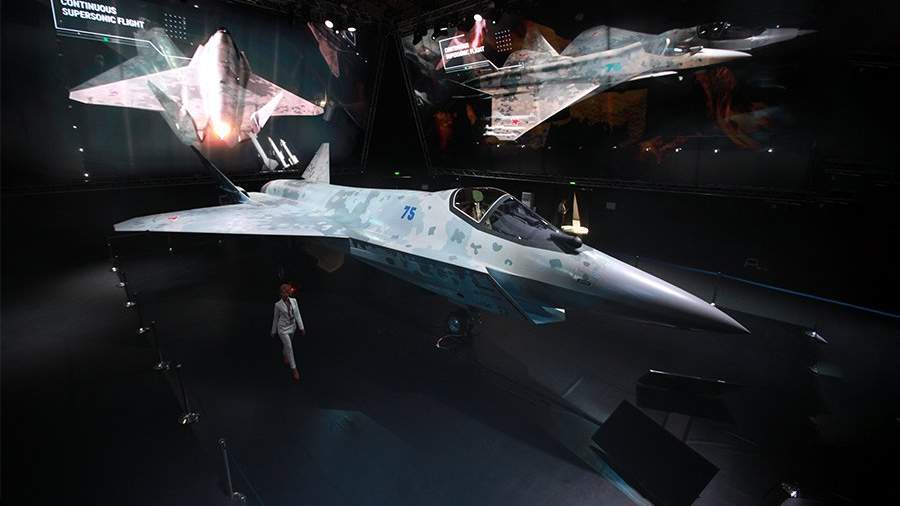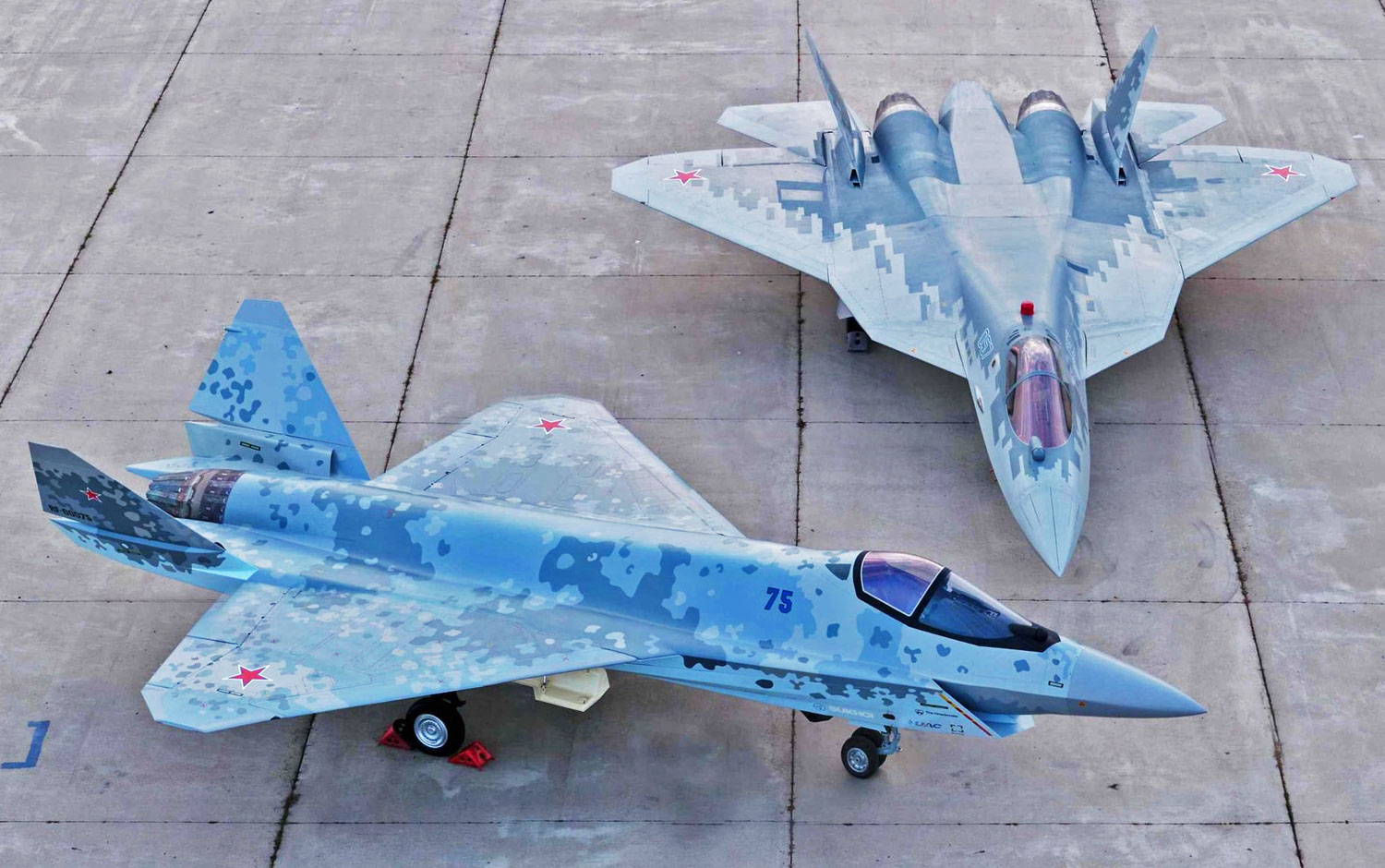Russia claims to have introduced modifications to the original design of its single-engine Su-75 Checkmate stealth fighter aircraft while also pursuing the development of additional variants.
United Aircraft Corporation (UAC), a Russian aerospace and defense corporation, has recently filed a series of patents with the Russian Federal Intellectual Property Service, revealing intriguing modifications to the original design of the Su-75 Checkmate.
These patents suggest UAC’s plans to develop a two-seat tandem version and an unmanned aircraft variant.
On December 28, 2022, the design office of UAC submitted a patent application for a “stealth aircraft with a single engine and single seat.” This application incorporates notable modifications to the original design of the Su-75 Checkmate aircraft.
One of the key alterations can be observed in the wing design compared to the model showcased at MAKS-2021 and the Dubai Air Show 2021, where the mockup was exhibited internationally for the first time.

This modification involves extending and angling the wing’s trailing edge, which results in an increased wing area and potentially a slight reduction in the aircraft’s rear radar signature.
Additionally, there seems to be a slight advancement in the engine installation. The fuselage has also undergone modifications, seemingly increasing the internal capacity of the aircraft.
This change suggests a possibility of enlarged side armament bays for housing short-range air-to-air missiles or an increased internal fuel capacity for the Checkmate, or perhaps both modifications have been implemented.
UAC has also introduced the concept of a “single-engine two-seater stealth aircraft.” Similar to other two-seater Sukhoi models, the modifications incorporate a tandem cockpit configuration, with the rear seat elevated to provide improved forward vision.
This design modification ensures increased visibility for the rear-seat occupant and contributes to the overall sleekness of the aircraft.
Apart from its role in training future Su-75 crews, the two-seat version of the aircraft can potentially serve as a “command center” for drones and unmanned combat aircraft of the Loyal Wingman type.
This configuration will enable the aircraft to effectively coordinate and manage operations involving multiple unmanned assets, demonstrating its versatility and adaptability in modern warfare scenarios.
Alongside the piloted aircraft design, an unmanned variant of the Checkmate was also presented, resembling its manned counterpart.
This unmanned version represents a key feature under development for sixth-generation air dominance systems, frequently described as “optionally manned” in various reports.
Nonetheless, including an unmanned variant highlights the future direction of air combat systems, highlighting the increasing role of unmanned technologies in achieving air superiority.
Speaking with EurAsian Times under the condition of anonymity, a former F-35 pilot remarked that modifications in the design of a fighter aircraft currently in the developmental process are to be expected and should not be viewed as extraordinary.
The pilot stated that “Russia’s Su-75 Checkmate is still primarily in the conceptual phase,” implying that further modifications can be anticipated based on the test outcomes required during the development stage.
That being said, despite the substantial journey still ahead to bring these designs to life as operational combat aircraft, valid doubts remain regarding Russia’s ability to fully advance this project, given its current focus on the conflict in Ukraine.
Can Su-75 ‘Checkmate’ F-35 Global Sales?
Unveiled at the MAKS-2021 International Aviation and Space Exhibition in Russia, the Russian defense industry has positioned the Checkmate stealth fighter as a state-of-the-art light tactical combat aircraft with futuristic capabilities.
Reports from state media regularly suggest that the country is committed to the timely development of the aircraft. Furthermore, there is a notable emphasis on the country’s intention to position the Su-75 Checkmate as an attractive option for international customers.
With a focus on affordability, the country’s defense sector aims to offer this stealthy aircraft at a competitive price, targeting the global market for potential exports.
The design of the Checkmate was reportedly formulated by capitalizing on the scientific and technical foundation established during the creation of the export variant of the Su-57E fifth-generation fighter.
It is believed that certain technologies such as onboard systems, cockpit, and other elements will also be derived from the Su-57 aircraft.
This approach is expected to reduce costs and enhance maintenance efficiency, as leveraging existing technologies and infrastructure can streamline production processes and optimize maintenance procedures.
Moscow has also said that the fighter jet will be able to seamlessly collaborate with unmanned aerial vehicles (UAVs) within a networked configuration.
This advanced capability will enable the warplane to exercise control over small drones, which will receive real-time information regarding the ongoing combat scenario through the utilization of transmission technologies.
But Western experts assert that Moscow has purposely designed the Su-75 Checkmate to directly compete with the US F-35 as a fifth-generation aircraft, aiming to appeal to Russian allies and potential customers worldwide.

Several US allies, including many European nations, are either currently using or in the process of acquiring the F-35 fifth-generation fighter aircraft. In contrast, Moscow has made only limited headway in achieving the deployment of stealth fighter aircraft in its Air Force.
“Even Russia’s Su-57 program has faced challenges in achieving the desired operational readiness and efficiency, which have impeded its extensive deployment,” the former F-35 pilot told EurAsian Times.
He explained that “comparing F-35 Joint Strike Fighter (JSF) Program with Russia’s Checkmate fighter program is illogical.”
According to the ex-pilot, “the future trajectory of the Checkmate program remains uncertain, while the F-35 program represents a well-established and advanced platform.”
Regarding the potential export of the Su-75, the former F-35 pilot stated that while the aircraft appears promising on paper and presents an attractive option for developing countries, the heavy sanctions imposed on Russia would hinder its chances of being ordered by any friendly nation.
The former pilot cited the example of Indonesia, which abandoned its plans to acquire the ‘Flanker-E’ aircraft and instead chose to procure French Rafales, possibly due to the potential impact of sanctions.
He noted, “Many countries, including India, are already developing their next-generation fighter jets. As a result, it would be illogical for these nations to acquire a new stealth fighter aircraft from Moscow.”
Nonetheless, the modifications to the original designs serve as evidence that the development of the Su-75 Checkmate is still ongoing, even though challenges and obstacles lie ahead.
- Contact the author at ashishmichel(at)gmail.com
- Follow EurAsian Times on Google News




